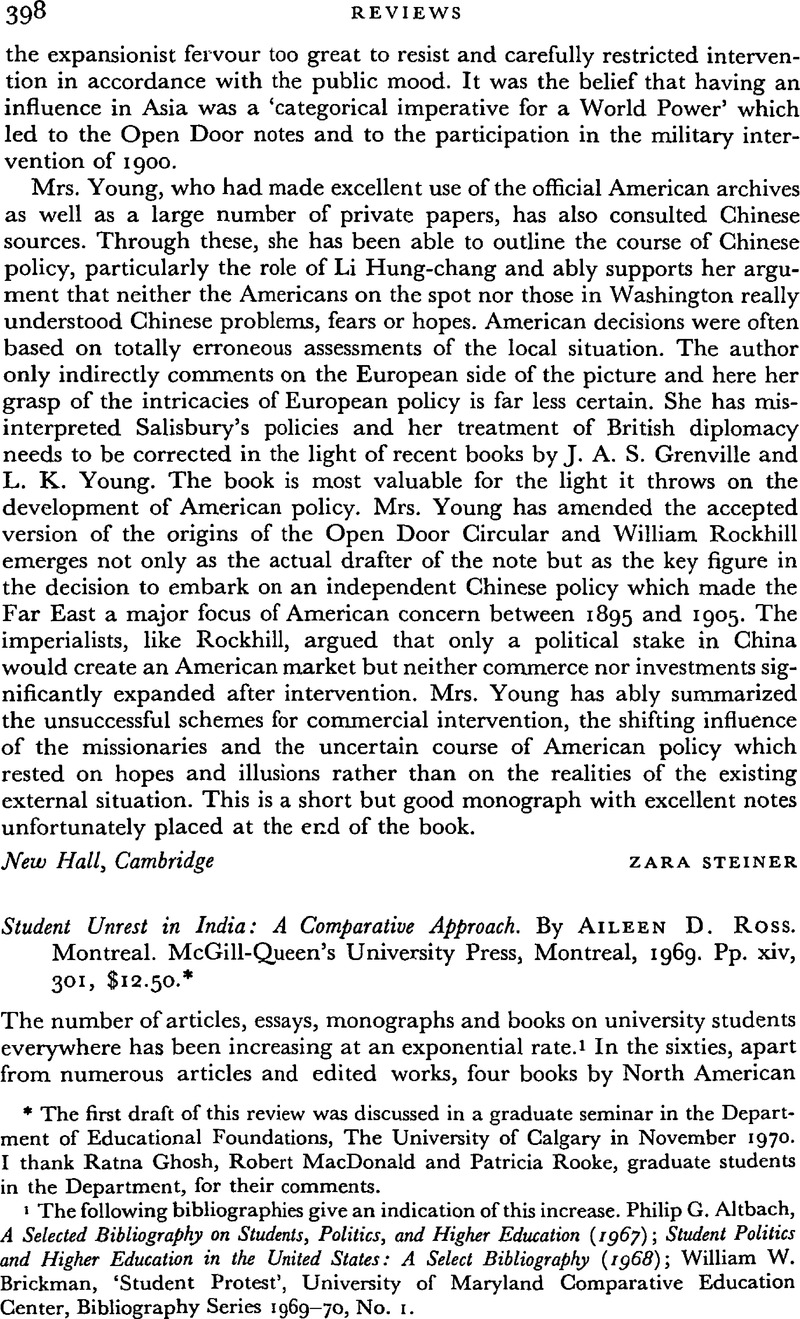No CrossRef data available.
Article contents
Student Unrest in India: A Comparative Approach. By Aileen D. Ross. Montreal. McGill-Queen's University Press, Montreal, 1969. Pp. xiv, 301, $12.50.
Published online by Cambridge University Press: 28 November 2008
Abstract

- Type
- Reviews
- Information
- Copyright
- Copyright © Cambridge University Press 1971
References
* The first draft of this review was discussed in a graduate seminar in the Department of Educational Foundations, The University of Calgary in November 1970. I thank Ghosh, Ratna, MacDonald, Robert and Rooke, Patricia, graduate students in the Department, for their comments.Google Scholar
1 The following bibliographies give an indication of this increase. Altbach, Philip G., A Selected Bibliography on Students, Politics, and Higher Education (1967); Student Politics and Higher Education in the United States: A Select Bibliography (1968); Brickman, William W., ‘Student Protest’, University of Maryland Comparative Education Center, Bibliography Series 1969–1970, No. I.Google Scholar
2 The other three are: Altbach, Philip G., Student Politics in Bombay (Bombay: Asia Publishing House, 1968);Google ScholarCormack, Margaret, She Who Rides a Peacock: Indian Students and Social Change (Bombay: Asia, 1961);Google ScholarDibona, Joseph E., Change and Conflict in the Indian University (Durham, N.C.: Duke University Program in Comparative Studies on Southern Asia (Monograph No. 7), 1969.Google Scholar
3 Pp. 248–9. The blurb on the jacket claims that the study focusses on four questions. The fourth is: ‘Why is it that only a relatively small proportion of students are, as yet, activitists?’Google Scholar
4 For instance, can we take for granted that the rebellious behaviour of students in different societies is ‘somewhat similar’?Google Scholar
5 E.g. ‘…the central core of [New Left] leaders seem to be motivated by the desire for power and the joy of defying the university authorities, rather than by educational reform’ (p. 8).Google Scholar
6 See Bereday, George Z. F., ‘Chapter One. Theory and Method: A General Discussion’, Comparative Method in Education (New York: Holt, Rinehart & Winston, 1964), pp. 3–28.Google Scholar
7 Were the interviews conducted in 1965? If the answer is yes, the sub-sample for the Youth Festival Strike could not have participated in it in 1959 because they would have joined the colleges only in 1961–62 or 1962–63. Was part of the sample interviewed in 1961 and the rest in 1965? If the answer is in the affirmative, then one cannot even pretend that it is a ‘sample’. The book simply does not give the reader adequate answers to crucial questions like this.Google Scholar
8 The groups were Brahmins and Christians who are classified by the Mysore Government as ‘Forward’ Communities and Lingayats and Vokkaligas who are classified as ‘Backward’ communities (p. 118).Google Scholar
9 See Krishnan, B., ‘Social Prestige of Occupations’, Journal of Vocational and Educational Guidance, Vol. 3 (1956), pp. 18–12 in which Brahmins, Lingayats, Vokkaligas and Harijans are compared.Google Scholar Also see Cooke, David R., ‘Prestige of Occupations in India’, Psychological Studies, Vol. 7 (1962), pp. 31–7.Google Scholar Unfamiliarity with the relevant literature is again suggested when the author refers to Peterson's typologies of students (p. 244) but does not mention Clark's, Burton R. typologies in Educating the Expert Society (San Francisco: Chandler, 1962), Ch. 6, ‘Student Culture in College’.Google Scholar
10 Some of these are: goondas (ruffians); lakhs (100,000); advocate (lawyer); hartals (closing of public places in protest or sympathy); bandh (complete hartal); maidan (an open field).Google Scholar
11 See p. 47.Google Scholar
12 The author refers to this aspect in several places (pp. 84, 87, 95, 258) in the book.Google Scholar
13 See Koplin, Roberta E., ‘A Model of Student Politicization in the Developing Nations’, Comparative Political Studies, Vol. 1, no. 3 (10 1968), pp. 373–90;CrossRefGoogle ScholarWeinberg, Ian and Walker, Kenneth N., ‘Student Politics and Political Systems: Toward a Typology’, American Journal of Sociology, Vol. 75, No.1 (07 1969), pp. 77–96.CrossRefGoogle Scholar




